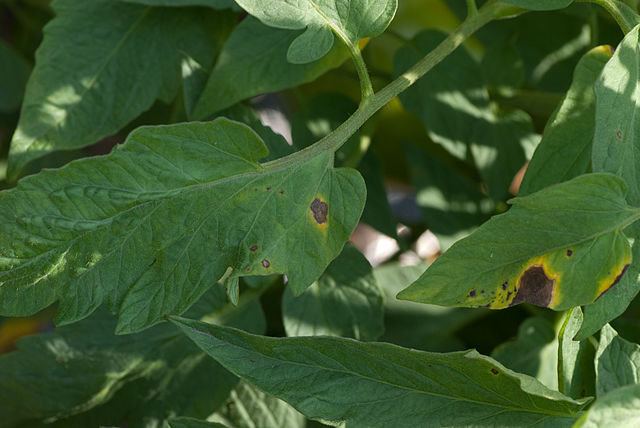Introduction
Early blight is a serious fungal disease that afflicts tomato and potato plants. It is caused by two closely related fungi: Alternaria solani and Alternaria tomatophilia. When A. tomatophilia is present in an area, it is the primary cause of early blight on tomato. If A. tomatophilia is absent, A. solani is the likely culprit. A. tomatophilia is more virulent on tomato plants than A. solani. A. solani infects potato plants more often than A. tomatophilia. Early blight infections affect entire plants, resulting in defoliation, and often, plant mortality.
Distribution & Habitat
Early blight occurs throughout the United States, wherever susceptible plants are present.
Hosts
Early blight primarily infects potato and tomato plants. Eggplants may also be infected, as well as several weeds and ornamental plants in the Solanaceae family, including black nightshade and hairy nightshade. Early blight is especially severe on plants that have been weakened by environmental stressors, or insect infestations.
Disease Cycle
Early blight overwinters on infected plant debris, and in diseased soil. In spring, once temperatures have risen and conditions are sufficiently moist, infectious spores are spread to vulnerable plants by splashes of rain, air currents, insect vectors, and pruning equipment. Early blight may also be transmitted via contaminated tomato seeds, transplants, or potato tubers. The lower leaves of susceptible plants can be infected when they make direct contact with diseased soil. Once a plant has been infected, it will form leaf spots within five to ten days. Plants can be infected at any stage of their development. Early blight infections can occur throughout the growing season. High temperatures, and wet humid conditions are conducive to the spread of early blight.
Symptoms of Infection
Early blight symptoms initially appear on older leaves as small, brown spots, with dark brown concentric rings. As the infection advances, the leaf spots spread outward, causing the affected plant to turn yellow, wither, and expire. Severely infected plants will be rapidly defoliated. When plants are defoliated, sunscald may occur. On seedlings, stems are infected at or just below the soil surface. The stem proceeds to rot, turning brown, and assuming a dry, sunken appearance. If the infection girdles the stem, the seedling will wilt and die. Lesions that develop on infected fruit are leathery and black, with raised concentric ridges. Fruit lesions generally appear close to the stem. Infected fruit and leaves may be prematurely shed from the plant.
Management
- Vulnerable plants should be pruned or staked to improve air circulation, and promote a rapid drying of the leaves. Disinfect pruning tools using a solution composed of nine parts water and one part bleach.
- Use drip irrigation or soaker hoses to water susceptible plants. This will allow the foliage to remain dry when the plant is being watered.
- Copper-based fungicides can be applied to infected plants to combat early blight. Subsequent applications should be administered at 7 to 10 day intervals, as needed.
- Remove and dispose of garden debris following harvest.
- Practice crop rotation every two to three years to decrease the incidence of early blight infections. Select plants that not vulnerable to early blight infections.
- Avoid composting infected plant material.
- Numerous tomato cultivars exhibit a mild resistance to infection from early blight. Some of the most notable cultivars include ‘Defiant PhR’, ‘Early Cascade’, ‘Floramerica’, ‘Iron Lady’, ‘Jasper’, ‘Jetstar’, ‘Juliet’, ‘Manlucie’, ‘Mountain Magic’, ‘Mountain Supreme’, ‘Supersonic’, ‘Surecrop’, and ‘Verona’.
Photo courtesy of Dwight Sipler CC-by-2.0


